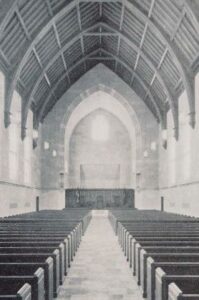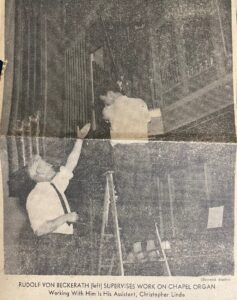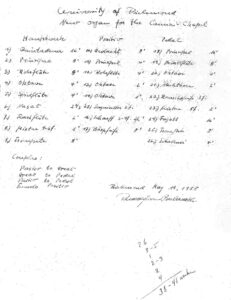
Cannon Memorial Chapel, before the organ (The Web, 1931)
When the Henry Mansfield Cannon Memorial Chapel was officially dedicated, six days before the Stock Market Crash of 1929, it didn’t have an organ. During the hard times that followed, wealthy donors were scarce, so in 1933 the sophomore class of Westhampton College took matters into their own hands. With proceeds from dances and benefit performances, the students’ Organ Fund eventually grew to $600; a pipe organ, however, would have cost more than ten times that amount. In April 1936, Music Department chair F. Flaxington Harker gave the first organ performance in the Chapel, playing a Hammond electronic organ borrowed from the Walter D. Moses Company in downtown Richmond. Two years later, the University purchased a similar Hammond organ, which served for the next twenty-odd years.

(Richmond News Leader, Dec. 15, 1961)
By the late 1950s, it was clear that a new chapel organ was needed, and John White, then chair of the Music Department, convinced University President George Modlin that it should be a real pipe organ. After extensive research, the University selected Rudolf von Beckerath, a German organ builder not yet known in the U.S. In September 1961, after some two years of measuring and building, 36 crates arrived from Hamburg, Germany. According to music professor Suzanne Kidd Bunting, three craftsmen spent two months assembling and installing the new organ before Beckerath himself arrived to oversee the finishing touches. On February 9, 1962, a standing-room-only crowd heard the organist Robert Noehren inaugurate the new instrument.

Beckerath’s preliminary specifications for the chapel organ
Additional modifications were made in 1976, when the adjacent choir loft was enlarged and the organ’s pipes were surrounded by wood paneling. Ten years later, Suzanne Bunting gave a 25th-anniversary recital. In 2002, the Staunton-based organ builder George Taylor, a former Beckerath apprentice, gave the instrument a complete restoration, and in 2012 a 50th-anniversary concert was performed by UR alumni Michael Simpson, Thom Robertson, and Bruce Stevens.